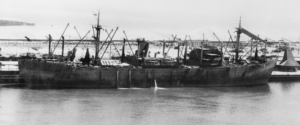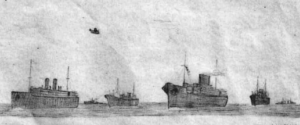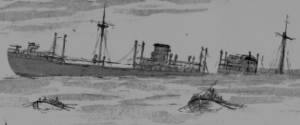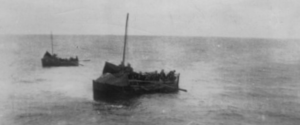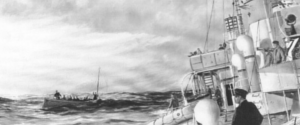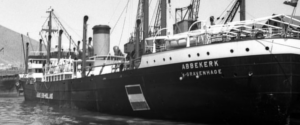Kiel (Germany). U604 sets off on her first patrol

1 August 1942. After 7 months of training in the Baltic Sea U-604 is ready for her first patrol. She leaves Kiel and cruises through Kattegat than skirting the coast of Norway into the North Sea. She cruises around the British Isles at a very large distance and will reach her assigned ‘hunting grounds’ West of Ireland in two weeks. This detour is just for once. Her patrol ends at Brest at the French coast.. This position will make it a lot easier to reach the convoys
At the beginning of the war with England Germany had 26 operational oceangoing submarines or U-boats of which one third was active. ( the others training, getting supplied or on the outward or return journey). By now there are, at any given time, at least 100 U-boats at sea, of which some on the outward or return journey. But these journeys last not nearly as long now since Germany can use ports at the French coast.
The battle of the Atlantic, state of affairs:
From the German perspective the war isn’t going as well as expected, but surely not bad at all. In Northern Africa, despite British efforts, Rommel seems well on his way to push through to Egypt and the Middle East. Germany and Italy control the Mediterranean Sea and are starting a new offensive against Russia.
The main objective of the war at sea against England is blocking the supply of Great Britain and through that making it impossible for them to fight. And so preventing any possibility for the invasion/liberation of Europe. Even though German surface ships by now only play a limited role, the U-boats in their rapidly expanding numbers seem to be well on their way to win this ‘Tonnage War . Despite the higher efficiency of the convoys which makes it that much harder for the U-boats to sink ships, the U-boats have also increased their efficiency by attacking in groups (‘Wolfpacks ). And allthough the losses of U-boats are much higher than the year before they seem pretty well on their way “to sinks ships faster than they can get build“.

In 1942 the majority of ship losses took place in US waters. (source: https://www.junobeach.org/flash/en/)
As Hitler declared war on the US in December 1942 England thought salvation was near. They hoped for more warships, planes, merchant navy ships and crew from the US. But nothing could be further from the truth. The US had their focus on the Pacific and merchant ships which had safely crossed the Atlantic in their English convoys were now sunk in large numbers in American waters. Germany’s new long distance U-boats were sent to the American East coast and the Caribbean in droves to deliver fear and destruction amongst the merchant ships.Without blackouts on the coast, lighthouses still working and without their convoys the ships were sitting ducks for the Germans who called this second Happy Times .
In retrospect it is staggering, almost criminal, that it took the US more than half a year to take serious measures while ignoring all the hardly learned lessons by the British. Almost 700 ships were already lost by the time the convoy system and blackouts were widely introduced.
Abbekerk
As Abbekerk prepares to leave Trinidad the convoy system and fight against U-boats starts to take shape in the American waters. Several U-boats are sunk and Germany starts to withdraw the U-boats en deploys them back to the north Atlantic Ocean. Abberkerks crew obviously doesn’t know all this and beside that, their fast sailing ship is deemed safer to sail alone than in convoy. So she is sent to England, sailing independendly, outside the normal (convoy) searoutes.

